A good 12V fridge is one of the biggest investments you’ll make for your DIY van build. But there are a ton of options out there, and you need to know that you’re getting the best van fridge for your needs and budget that will hold up to the daily grind of life on the road.
Even if you’re not a vanlifer, a 12 Volt portable fridge is great for food storage on camping trips and long road trips. Imagine always having cold food and drinks at your campsite or as your travel without having to deal with melting ice.
In this post, we help you wade through the options for 12V portable refrigerators. We discuss whether those expensive 12 Volt fridges are really worth the cost, and what you may be giving up with the cheaper units. We go over the pros and cons of the best campervan fridges and give our reviews based on our own testing and our years of van life experience.
Our Top Picks for the Best 12V Refrigerator for Vanlife
|
Rugged and ultra-efficient for half the cost of high end brands. Sizes from 45L to 74L. Single and dual zone. Enter GNOMAD for 12% off |
Ssleek looks and upgraded features, but less efficient. Sizes from 35L to 90L. Single and dual zone. Enter GNOMAD for 12% off |
Best-in-class energy efficiency and cutting edge technology at a higher price. Sizes from 24L to 99L. Single and dual zone. Enter GNOMAD for 5% off + free shipping |
Solid, efficient, and inexpensive 12V vanlife refrigerators. Sizes from 32L to 50L. Single zone. Enter GNOMAD90 for $90 off 53Qt model or GNOMAD for 16% sitewide |
The legendarily efficient and reliable overlanding fridge with modern upgrades. Sizes from 40L to 99L. Single and dual zone. |
The OEM for many generic 12V fridge brands. Solid performance and affordability for valifers on a budget. Sizes from 35L to 55L. Single zone. |
|
|
|
Rugged and ultra-efficient for half the cost of high end brands.
Sizes from 45L to 74L. Single and dual zone.
Enter GNOMAD for 12% off
Ssleek looks and upgraded features, but less efficient.
Sizes from 35L to 90L. Single and dual zone.
Enter GNOMAD for 12% off
Best-in-class energy efficiency and cutting edge technology at a higher price.
Sizes from 24L to 99L. Single and dual zone.
Enter GNOMAD for 5% off + free shipping
Solid, efficient, and inexpensive 12V vanlife refrigerators.
Sizes from 32L to 50L. Single zone.
Enter GNOMAD90 for $90 off 53Qt model or GNOMAD for 16% sitewide
The legendarily efficient and reliable overlanding fridge with modern upgrades.
Sizes from 40L to 99L. Single and dual zone.
The OEM for many generic 12V fridge brands. Solid performance and affordability for valifers on a budget.
Sizes from 35L to 55L. Single zone.
After our own hands-on testing and extensive research, we’ve narrowed the huge list of 12 Volt refrigerators down to a handful of the best van fridges that we recommend based on our years of living full time van life.
Sporting the ultra-efficient Danfoss SECOP compressor and stainless steel construction, these fridges have everything you need for life on the road for about half the cost of higher end units.
Available in sizes from 45 to 74 liters, and both single and dual zone.
Enter discount code GNOMAD for 12% off at Icecofreezer.com
In our opinion, the Iceco VL series 12 Volt refrigerators are the best overall value for portable fridges for vanlife. They offer an excellent combination of top-quality components, rugged construction, performance on par with higher-end 12 Volt fridges, and affordable pricing that’s tough to beat. The low power consumption of the VL series is on par with the most efficient fridges out there, and these fridges cost about half as much as high end alternatives.
The VL series comes in a variety of sizes to fit any need, from smaller single-zone to large dual-zone. Single zone sizes include 45L (VL45S), 60L (VL60S), and 74L (VL74S). Dual zone sizes include 60L (VL60D) and 65L (VL65D).
With their sleek looks, rugged design, and upgraded features, ICECO's VL Pro series fridges can go toe-to-toe with much more expensive modern-design fridges.
Available in sizes from 35L to 90L, and both single and dual zone.
Enter discount code GNOMAD for 12% off at Icecofreezer.com
If you want a van life fridge that looks a little more “modern” but still doesn’t sacrifice on features or affordability, take a look at Iceco’s upgraded VL Pro series. These rugged and slick-looking overlanding refrigerators feature side-opening lids that swing from both sides and dual DC power ports for ultimate flexibility. However, VL Pro refrigerators consume a bit more power than the regular VL series.
The VL Pro series comes in a variety of configurations, including larger dual zone sizes. Single zone sizes include 35L (VL35 ProS), 45L (VL45 ProS), and 60L (VL60 ProS). Dual zone sizes include 75L (VL75 ProD) and 95L (VL95 ProD).
Featuring best-in-class energy efficiency, cutting edge technology, rugged build quality, and overall reliability, CFX3 fridges are the top choice of many vanlifers for good reason.
Available in sizes from 24 to 99 liters, and in both single and dual zone.
Use coupon code GNOMAD for 5% off + free shipping at Dometic.com.
The Dometic CFX3 series represents the top-of-the-line when it comes to 12 Volt DC refrigerators for vanlife. These camper van fridges are extremely energy efficient, packed with advanced digital features, and come from Dometic’s well-known pedigree of producing rugged and innovative mobile living appliances. The CFX3 line includes the widest range of sizes and configurations, so it’s easy to find a unit that will meet your needs. The major downside is higher cost, but that may be worth it to you if you have the budget and want the “best of the best” for your rig.
Dometic CFX3 series refrigerators comes in a wide range of sizes, and both single zone and dual zone configurations. Single zone sizes include 25L (CFX3 25), 36L (CFX3 35), 46L (CFX3 45), 55L with built-in ice maker (CFX3 55IM), and 99L (CFX3 100). Dual zone sizes include 75L (CFX3 75DZ), and 95L (CFX3 95DZ).
Solid, efficient, and inexpensive 12V vanlife refrigerators. Available in sizes from 34 quart (32L) up to 53 quart (50L).
Coupon codes for Bougerv.com:
- GNOMAD90 for $90 off the 53-Qt fridge
- GNOMAD for 16% off sitewide
BougeRV E-Series 12V portable refrigerators offer incredible bang for your buck. They are highly efficient 12V DC refrigerators with all the basic features, and they’re less than 1/3 the cost of the high-end brands (with discounts). And unlike some other cheap 12V fridges, this van life fridge has a brand behind it that’s committed to the product and the van life community. If you want refrigeration in your van without breaking your budget, the BougeRV E-Series are some of the best fridges for vanlife on the cheap.
The BougeRV E-Series only comes in a single-zone configuration, and the size range is rather limited. Sizes include 32L (34Qt), 40L (42Qt), and 50L (53Qt). BougeRV also makes other cheap vanlife fridges that are worth a look.
What to Look for in the Best Portable Refrigerator
We’ve lived with, used, and tested many portable refrigerators in a variety of situations: full time van living for three years, living off grid in the mountains for two years, car camping, and epic road trips. Based on our experience, here’s a quick rundown of what to look for when you’re choosing a 12V portable fridge for your needs.
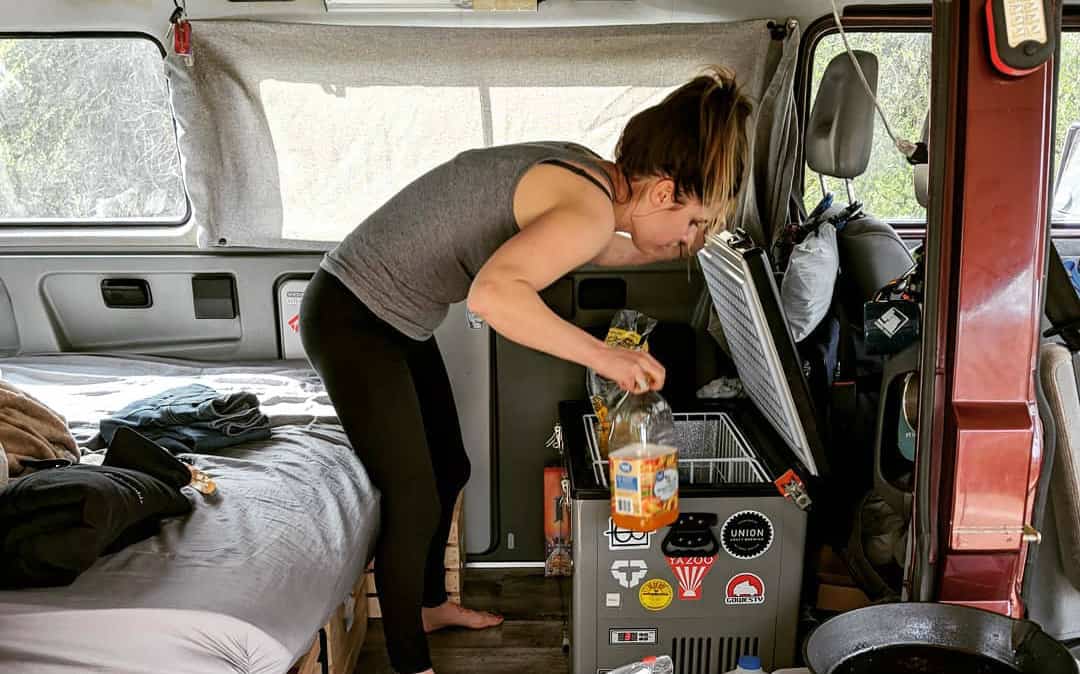
Type of Portable Refrigerator
There are a few different options for keeping food cold in your van, but 12V compressor fridges are by far the best option. Let’s briefly go over the different types of van life refrigerators.
12V compressor refrigerators. These camper van fridges are designed for rugged use in 4×4 vehicles and boats, and they’re built with durability and efficiency in mind. Electric compressor fridges feature highly efficient, variable speed compressors that are fast cooling and draw very little power. This is hugely important when you’re running a van or RV fridge on the limited battery capacity of a power station or off grid electrical setup. These portable fridges also come in a variety of configurations, including chest-style, upright, and dual-zone fridge/freezers, and they have the ability to run while at an incline of 30 degrees or more.
This combination of features, options, and value makes portable compressor fridges the best option for van life, camping, and long road trips.
Thermoelectric coolers (like the Coleman Powerchill) are not so much portable fridges as they are portable coolers that run on electricity, and they have significant drawbacks compared to compressor fridges. Thermoelectric coolers have limited cooling power, with the ability to cool only 40° or less below ambient temperature. They also draw much more power than 12V compressor fridges, making them difficult to run on an off-grid electrical system. Thermoelectric coolers are fine for keeping drinks and food cool on shorter road trips, but they’re just not ideal for longer road trips, camping, boondocking, or living in a van.
3-way absorption refrigerators can run on 12V DC, AC power, or propane. But they’re wildly inefficient on DC or AC power, and running them on propane means more fuel lines to deal with. Absorption fridges also function best on level ground. While these fridges are often suitable for RVs, they’re not the best choice for van life.
Standard coolers can be a good option if you want to get on the road without throwing down for a 12V fridge and electrical system right away. Many high-performance coolers can hold ice for 5-10 days, giving you plenty of time off in the wilderness before you need to restock. However, the cost of ice adds up and you’ll need to source ice, drain ice melt, and potentially deal with water-logged food.
Bottom Line: 12V compressor fridges are the best choice for van life, camping, boondocking, and longer road trips. If you’re looking at a fridge outside of our recommendations, make sure it’s an actual compressor fridge and not a thermoelectric cooler (sometimes advertised as “portable car refrigerators”).
Chest-Style vs Upright
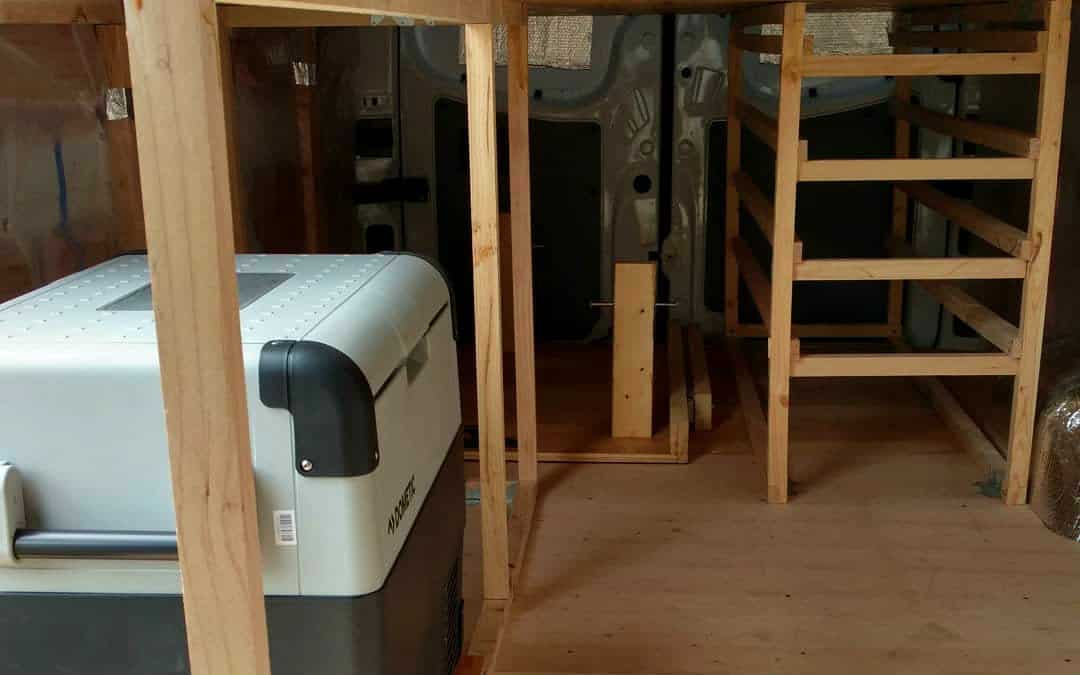
In the world of 12V DC fridges, there are two broad fridge styles: top-opening chest fridges and front-opening upright fridges. While you may prefer the form factor of an upright front-loading fridge because it’s similar to a standard house refrigerator, chest-style fridges have some big advantages that make them a better choice for most campervans.
Chest fridges can hold more. The top-down layout of chest-style 12 Volt fridges allows you to tightly pack them to fit more stuff and eliminate any unused space. With a front-opening fridge you’ll need to stack items on shelves, which often leaves wasted space. All of this means less storage capacity without any real gains in organization, since you’ll still need to shift items around to get to others.
Chest fridges are more energy efficient. Most of the cold in any fridge is actually “stored” in the food, so fridges that are packed full are much easier to keep cool. With the interior shelf arrangement of upright-style 12-Volt refrigerators you’ll end up with wasted empty space that’s more difficult to fill. Also, with chest fridges cold air pools at the bottom where it has nowhere to escape. But with upright fridges, you’re relying on the insulation seal around the door to keep cold air in when the door is shut, and any accumulated cold air will spill out whenever the door is opened.
Chest fridges are better for backwoods adventures. If your food shifts around inside your fridge while you’re bouncing down those gnarly backroads, with a chest fridge you won’t have to worry about your eggs flying out at you when you get to your campsite and open the fridge to grab a cold one. But with an upright-style DC refrigerator, you never know what will happen when you open the door.
Chest fridges are portable and can double as coolers. With handles and a cooler-shaped body, you can more your chest-style 12V fridge around your van, bring it inside if you’re stationary somewhere, or stow it outdoors in cool weather for greater energy efficiency. Many chest-style 12-Volt refrigerators also feature drain plugs that allow them to dump in ice and use them as a cooler if you lose electricity. This is something you just can’t do with a front-opening upright refrigerator.

Although we think chest fridges are the best option, upright fridges have some advantages in terms of planning a campervan kitchen layout. Upright fridges have a smaller footprint, which can make them easier to incorporate into a floor plan, and you don’t have to worry about overhead clearance for opening the lid. However, you will need to permanently mount an upright-style fridge, and you may have to get down on your hands and knees to see inside an upright fridge unless you mount it a few feet in the air. Chest fridges are much simpler to incorporate into a build, but it’s all down to your personal preference.
Bottom Line: Chest-style fridges are more efficient, rugged, and practical for most van builds. However, upright-style fridges may fit better into your layout – it all depends on your preferences.
Size (Interior Capacity)
Buying a van fridge that’s too big means spending more than you need to, and giving up precious space in your van. Likewise, having a fridge that’s too small means shopping for groceries more frequently.
So how much fridge space do you need? Here are some general guidelines.
- If you’re looking for a road trip fridge, a smaller car fridge under 35L is a good size.
- If you need a fridge for short camping trips, a fridge in the 35L range should be plenty, even for a small family.
- If you’re a solo full time vanlifer, you may be just fine with a fridge that’s 35L or smaller, but you could go bigger.
- If you’re a full time vanlife couple, you will be best served with a campervan fridge that is at least 45L.
- If you’re a full time family, you will likely need a fridge that’s 65L or larger, or a dual-zone fridge/freezer.
In our years as a full time vanlife couple, our 50L DC refrigerator had plenty of space for about a week’s worth of food, plus some kombucha and beer. As a camping fridge on several day trips with our toddler, a 35L fridge has more than enough space for food and cycling in beer as needed.
Single Zone vs Dual Zone
A single zone fridge is the basic configuration that should meet most needs. However, if you have a larger family and/or really need to keep some things frozen, you could consider getting a larger dual-zone refrigerator with a dedicated freezer compartment and dual temperature controls.
Dual-zone fridges have two separate compartments that can be set to different temperatures. This allows you to run one side as a refrigerator and one as a freezer (you can also set both sides to freezer temperature, or use both as a fridge). If you often keep frozen food items, or if like boondocking off grid for extended periods and want to resupply less frequently, then a dual zone fridge could make sense.
However, dual-zone refrigerator/freezers have some downsides. They’re mostly available in larger sizes, so they make less sense for single people. They’re also more expensive and use more power (sometimes significantly more), so you’ll need more electrical capacity. And if you’re not a fulltimer, a dual zone fridge reduces your flexibility because you only have a huge fridge.
On the other hand, single zone van fridges use less power, are cheaper, and can be more versatile. Smaller size = lighter weight and greater portability. And if you need a separate freezer for a specific journey you can always run a second singe zone fridge as a freezer. The rest of the time you’ll have a more manageable refrigerator. It’s also worth nothing that single zone refrigerators can be used as either a fridge or a freezer depending on your needs.
Bottom Line: Consider dual zone if you’re full time in your rig, tend to camp in places without easy access to grocery stores, and tend to store lots of frozen food. Otherwise, single zone fridges are cheaper and use less power.
Pricing (and your budget)
Budget is always a consideration when buying something, but how much do you need to spend on a 12 Volt refrigerator? Higher-end camper van refrigerators have only gotten more expensive over the years, but there are now 12V fridge brands like Iceco that can go toe-to-toe with pricier units in many respects, and for half the cost. Iceco is the sweet spot in terms of value, but there are a handful of budget brands that make decent fridges for even less (just be careful here).
Top brands like Dometic and ARB make excellent units, but they are a tough sell when there are solid options for significantly lower cost. If we had an unlimited budget then a high-end fridge would be at the top of our list, but in all honesty spending $1000-$1200 (or more) on a fridge is not the best bang-for-your-buck for most people. It may be better to just grab something like an Iceco and spend that extra money on solar panels.
All that being said, if you’re a full-timer, we think a 12V refrigerator is an area of your van build where it’s worth investing in quality. But if you don’t have the budget for a top brand, there are some great values out there that should serve you well for many years.
Bottom Line: High end fridges are often great products, but there are several more affordable options that offer a better value and perform nearly as well.
Exterior Dimensions and Weight
Make sure the van refrigerator options you’re considering will fit where you need it to go. Some brands have a bigger footprint but are squatter, while others are taller with a smaller footprint. At the end of the day, whether a certain fridge will fit your van’s configuration can be the deciding factor. Weight could also be a factor in your decision if you need to move the fridge around regularly or if you’re trying to stay under a certain weight limit.
Energy Efficiency and Compressor
When you’re off-grid, energy efficiency is a huge concern. Batteries and solar are expensive, and the more efficient your appliances are, the more money you can save in capacity. All of the fridges we recommend here are efficient enough for van life usage, but some brands and models are able to achieve greater energy efficiency due to differences in insulation, configuration, and compressor controls. Make sure to consider the average power draw of any fridge you’re considering when you’re planning your electrical system.
It’s also helpful to know what type of compressor your fridge has. Many 12V portable refrigerators on the market use the gold-standard Danfoss SECOP variable speed compressors, but some brands (including Dometic, Engel, some ARB units, and Whynter/Edgestar) use their own compressors. Some of the cheaper fridges (like BougeRV) use Wancool compressors, which are Chinese-made SECOP rebrands, and Alpicool uses LG compressors. All of the fridges we recommend here have solid compressors, and generally speaking it’s a good sign if a no-name RV fridge you’re considering has a SECOP compressor.
Direction the Lid Opens
This may seem like a minor consideration, but it can make a big difference in your van setup. Some 12-Volt portable refrigerators have lids that hinge from the back, while others have side-hinged lids. If you need extra flexibility, some refrigerators (like Iceco’s VL Pro series) have side-hinge lids that can open two ways, so you can access your food storage space from either side.
Side-hinge lids need less overhead clearance to fully open, and it may be easier to view and reach the contents. But the best lid direction for you will depend on your specific setup. In our first van, we had our rear-hinged ARB Classic fridge between the front seats – so having the hinge at the rear actually made it easier for us to access everything.
Standard Features and Extra Features
Most portable 12V fridges have the following standard features:
- Ability to operate at an incline (30° or more).
- LED lighting inside the fridge.
- Floor drain plug for easy cleaning.
- Low voltage cut off to protect your batteries.
- Eco mode for low power consumption and Max mode for rapid cooling.
- Dividers and lift-out organizer baskets.
Some fridges include more advanced features like a digital control panel, remote readouts, wifi apps, and additional accessories.
It’s also important to look at the temperature range of any 12 volt fridge you’re considering. Most DC refrigerators can cool down to at least 0°F. If you need more cooling power you’ll be more limited, but there are plenty of options available.
Warranty and Reliability
Factory warranties give you a degree of security in case something goes wrong and needs to be fixed or replaced. However, we don’t want to overstate the importance of warranties. While a 12V refrigerator advertising a 3-year or 5-year warranty is awesome, the big question is how easy it will be to get warranty servicing.
Reputation is also a factor here. The big brands like Dometic, ARB, Engel, and Iceco generally have good reputations for reliability. Danfoss compressors are known to be reliable, so budget RV fridges with this compressor are usually a safer bet. You will roll the fewest dice if you stick with major brands or fridges with Danfoss compressors.
Best Van Fridge Overall: Iceco VL Series (single-zone and dual-zone)
Sporting the ultra-efficient Danfoss SECOP compressor and stainless steel construction, these fridges have everything you need for life on the road for about half the cost of higher end units.
Available in sizes from 45 to 74 liters, and both single and dual zone.
Enter discount code GNOMAD for 12% off at Icecofreezer.com
What do you get when you take a Danfoss SECOP compressor with a 5-year warranty, bulletproof construction, performance and efficiency worthy of a Dometic fridge or ARB, and wrap it in a package that’s nearly half the price of the high end fridge brands? Well, you get an Iceco VL-series refrigerator.
The Iceco VL-series 12 Volt refrigerators offer the best overall value out there in the portable RV refrigerator market. Not the cheapest nor the most expensive fridges, they sit in a Goldilocks sweet spot of top notch components, efficiency, and affordable pricing. And value is not all they offer. The VL-series can easily compete with the performance of any fridge out there, easily making this the best fridge for van life overall.
Plus, they come in a multitude of sizes from 30L up to 74L, and they’re available as both a single zone fridge and a dual zone fridge/freezer. So no matter your needs or van configuration, the VL-series will work for you.
Energy efficiency: The VL-series is by far the most energy-efficient of Iceco’s fridges, with average power draw on par with the highly efficient fridges from Dometic and ARB. (Note: Iceco is the rare manufacturer that actually publishes *accurate* consumption numbers, so you can look at the specific power draw of any model you’re looking at).
During our own field testing of the Iceco VL45 single-zone refrigerator, we clocked the average Amp draw at 1.05A per hour, which is excellent – even better than Iceco’s own published numbers of 1.20A per hour. Other independent tests put the VL45 at 0.72A per hour. Similar testing of the VL-60 dual zone fridge revealed average power consumption of 1.77A per hour in max mode, and 1.27A per hour in eco mode. This is highly efficient for a dual-zone refrigerator/freezer that’s actively running the freezer compartment. Users report similarly efficient numbers.
Price and overall value: In our opinion, Iceco VL-series refrigerators offer the best overall value in the van life refrigerator space. They are nearly half the cost of higher-end brands, yet they are close to on par in terms of efficiency, components, durability, and important features.
Iceco discount codes: Use coupon code GNOMAD for 12% off at Icecofreezer.com.
Warranty and reliability: Iceco offers a 5-year warrant on the super-reliable Danfoss SECOP compressor that they use in their 12V refrigerators. They only offer a 1-year warranty on all other parts, which is lower than most other 12V refrigerator brands. However, we have not heard of any reliability issues with these fridges.
Features and accessories: Iceco refrigerators offer all the basic features that we’ve come to expect in 12V refrigerators, including battery protection and eco/max cooling modes. They don’t have a whole lot of bells and whistles such as digital features, but that’s not a selling point for many. As far as accessories, Iceco offers a slide mount and an insulated cover, both of which work for many of their fridge models.
Bottom Line: Iceco VL-series fridges offer an excellent value that’s tough to beat. They are rugged and well-made, include top-quality components like Danfoss SECOP compressors, and they are among the most efficient 12V refrigerators out there. All for a price that makes more sense for more people than what the high-end brands charge.
Also Great: Iceco VL-Pro Series (single-zone and dual-zone)
With their sleek looks, rugged design, and upgraded features, ICECO's VL Pro series fridges can go toe-to-toe with much more expensive modern-design fridges.
Available in sizes from 35L to 90L, and both single and dual zone.
Enter discount code GNOMAD for 12% off at Icecofreezer.com
Iceco’s VL Pro series takes the overall awesomeness of their VL fridges, throws in some premium upgraded features, and puts it together in slick-looking package that any vanlifer would be proud to show off in their van. The standard VL Series can feel a bit utilitarian, whereas the VL Pro series feels built to compete directly with flashy units like the Dometic CFX series fridges and the ARB Zero.
Looks aside, VL Pro refrigerators include several features that amp up its flexibility in a van build, including a removable, dual-open lid, and DC power ports on both sides. This means it will be easier to position this fridge however you need it in your campervan or overlanding vehicle. Iceco even includes spare parts, which will come in handy in case anything breaks out on the road.
As much as we like Iceco VL Pro series refrigerators, its higher cost and lower energy efficiency kept it out of the top spot. In our testing, the VL Pro used over 40% more power than the VL Series (about 0.5A per hour). This won’t make or break your battery system, but it’s definitely something to think about in your planning. Still, if you have the battery capacity, these refrigerators are a solid choice and a much better value than anything from high end brands.
Energy efficiency: The VL Pro series is fairly energy efficient, but it falls behind our other recommended fridges. The 35L-45L units draw upwards of 1.76A per hour, when most competing fridges draw less than 1.25A on average. Again, not a deal breaker, but you need to make sure to account for this when planning your electrical system. (Note: Iceco is the rare manufacturer that actually publishes *accurate* consumption numbers, so you can look at the specific power draw of any model you’re looking at).
Price and overall value: Iceco VL Pro series refrigerators offer an excellent value, especially compared to higher priced brands. Although these fridges are a bit less efficient, they offer outstanding durability, useful features, and an attractive form factor that goes toe-to-toe with more modern “pro” fridge options.
Iceco discount codes: Use coupon code GNOMAD for 12% off at Icecofreezer.com.
Warranty and reliability: Iceco offers a 5-year warrant on the super-reliable Danfoss SECOP compressor that they use in their 12V refrigerators. They only offer a 1-year warranty on all other parts, which is lower than most other 12V refrigerator brands. However, we have not heard of any reliability issues with Iceco fridges.
Features and accessories: Iceco VL Pro refrigerators offer all the basic features like battery protection and eco/max cooling modes. They also include handy dual-open lids, spare parts, and a variety of power ports including DC ports on both sides. As far as accessories, Iceco offers a slide mount and an insulated cover, both of which work for many of their fridge models.
Bottom Line: Iceco VL Pro series refrigerators are very high quality and a worthy option if you value the upgraded features and sleek form factor – especially if you don’t want to shell out a grand+ for a Dometic or ARB. However, these fridges are not the most efficient out there, so make sure to factor that into your planning.
Upgrade Pick #1: Dometic CFX3 Series (single zone and dual zone)
Featuring best-in-class energy efficiency, cutting edge technology, rugged build quality, and overall reliability, CFX3 fridges are the top choice of many vanlifers for good reason.
Available in sizes from 24 to 99 liters, and in both single and dual zone.
Use coupon code GNOMAD for 5% off + free shipping at Dometic.com.
We think the Dometic CFX3 line of 12V portable fridge/freezers are the top high-end choice for a vanlife refrigerator. Dometic (or Waeco, as they’re also known) has always made solid fridges, but their newest models are setting the bar for the 12V portable refrigerator class.
Dometic CFX fridges are highly efficient and use very little power. They’re built to be rugged and durable, with solid construction, stainless steel hinges, and reinforced corners. They have advanced features, like the ability to control the temperature through a wifi app.
The most popular version of this fridge is the CFX3 45-L, but Dometic also offers CFX fridges in a variety of sizes, including dual-zoned fridge/freezers. So no matter what your refrigeration needs are, Dometic makes a CFX3 fridge to fit.
Energy efficiency. Based on our research, Dometic CFX3 fridges are the most efficient that we’ve found. We were not able to find any publicly available data online, so we called Dometic directly and asked them what they had. According to Dometic’s own testing, the CFX3 45L draws an insanely low 0.68A per hour on average (90°F ambient temperature with the fridge set to 39°F). Owners of this 12V portable fridge generally report power consumption at less than 1A per hour, which is consistent with Dometic’s numbers, so it’s safe to say that this is a very efficient camper van refrigerator.
Price and overall value. Dometic CFX fridges aren’t cheap, that’s for sure. They’re among the most expensive 12-Volt refrigerators for van life you can buy. But you do get what you pay for, including best-in-class energy efficiency, durability, and a slew of advanced features. CFX3 fridges may not be the best “value”, but they are excellent products that are worth the cost to some.
Dometic discount codes: Use coupon code GNOMAD for 5% off + free shipping at Dometic.com.
Warranty and reliability. In the US, Dometic offers a standard 2-year factory warranty on their products, with the option to purchase an extended warranty for up to 3 years. They offer a longer standard warranty in Australia. Dometic also has a solid reputation for reliability and support.
Features and accessories. Dometic CFX fridges are packed with features. They include more advanced features than any other 12V refrigerator on this list, including a reversible side-opening lid, the ability to control the fridge settings from the comfort of a wifi app, and a usb port for charging devices. The CFX line also includes all the standard portable fridge features like low voltage cutoff, digital controls, an interior light, and a drain plug. As far as accessories, Dometic makes a fridge slide and an insulated cover for CFX fridges.
Bottom Line: Dometic CFX3 12V refrigerators are the most efficient out there, they offer the most advanced features of any 12V portable fridge, and Dometic is well-known for producing top-quality 4×4 and mobile living components. The CFX3 is not cheap, but if budget is not a priority for you then it’s an excellent choice for your van.
Upgrade Pick #2: ARB 12V Refrigerators (various models)
Built for overlanding expeditions in the Australian outback, ARB fridges are insanely rugged and durable. The ARB Zero includes modern upgrades and easily competes with Dometic's offerings.
Available in sizes from 38 to 101 quarts, and both single and dual zone.
Reboot of the time-tested classic ARB 50-qt overlanding refrigerator, with upgraded features including Bluetooth.
The most rugged fridge ARB makes. This 63-qt fridge features 304 stainless steel weatherpoof construction, and an electronic locking keypad.
Designed for 4×4 expeditions in the Australian outback, ARB 12V portable fridge/freezers are known for their durability and ruggedness. They feature strong powder-coated zinc steel construction, and their very low power usage will help you keep your food cold on an off-grid solar setup. We’ve used the 50-Qt model daily since 2016, and its quality and reliability is just insane.
The downside to ARB refrigerators is cost – they’re pricier than many other 12V DC fridges out there. The quality certainly is there to back up the price and we don’t hesitate to recommend ARB fridges, but they aren’t exactly budget options.
Energy efficiency. ARB overlanding refrigerators are very energy efficient, trailing only the Dometic CFX fridges. During an extended power draw test we conducted on the ARB Classic 50-Qt fridge, we measured the average power draw at 0.95A per hour over nearly two weeks. ARB also makes power consumption test data readily available, and according to them the 50-Qt model draws a very low 0.87A per hour on average (based on a 27-hour test in 86°F ambient temperature, with the fridge set to 37°F). In a comparison test with an Engel fridge at 90°F ambient temperature (fridge set at 37°F), the ARB drew a low 1.35A per hour.
Price and overall value. ARB refrigerators are some of the most expensive van fridges out there. You can save a bit of money with other brands, but ARB makes top-quality, rugged, and efficient fridges. You really do get what you pay for with these.
Warranty and reliability. ARB offers an excellent 3-year warranty on their portable refrigerators, so you can be comfortable knowing that they stand by their products. We haven’t heard of any reliability issues with ARB fridges, and we’ve had zero problems with ours.
Features and accessories. ARB fridges include all the features you expect, like low voltage cutoff, digital display, interior lighting, removable lid, and drain plug. They also have a ton of accessories available, including fridge slides, tie-down straps, a transit bag, and a remote display. The accessories aren’t cheap, though!
Bottom Line: ARB fridges offer excellent durability and power efficiency – two top priorities when you live in a van. They also stand behind their products with a 3-year warranty and highly-rated customer support. They do cost a bit more than other options, but they’re well worth the price and we don’t hesitate to recommend them (our own ARB camper van refrigerator has been a kickass addition to our van).
Budget Pick #1: BougeRV E-Series (single zone)
Solid, efficient, and inexpensive 12V vanlife refrigerators. Available in sizes from 34 quart (32L) up to 53 quart (50L).
Coupon codes for Bougerv.com:
- GNOMAD90 for $90 off the 53-Qt fridge
- GNOMAD for 16% off sitewide
BougeRV sells the best among the slew of inexpensive Chinese mass-produced 12 Volt refrigerators for van life that are now all over Amazon and elsewhere. But the big differentiator between BougeRV refrigerators and all the others is that BougeRV seems committed to becoming a reputable brand in the vanlife, RV, and adventure space. This is an important indicator of reliability and support, as well as future expansion of the product line.
The BougeRV E-Series12V campervan refrigerators are extremely cheap, but they perform nearly as well as high-end brands and include all the basic features you would expect in a 4×4 fridge. The E-Series comes in sizes ranging from 30-qt up to 53-qt. We extensively tested their 53-qt model, and we were generally impressed with its quality, performance, and lightweight form factor.
If you don’t have a lot to spend on a vanlife refrigerator (or if you just don’t want to shell out the equivalent of a month’s rent for one appliance), then BougeRV deserves a hard look.
Energy efficiency. BougeRV uses Wancool compressors, which are cheaper rebranded versions of the highly-efficient and reliable Danfoss compressor. During our own hands-on testing, we measured the 24-hour average power draw of the 53-qt model at 0.97A per hour on Eco mode, and 1.33A per hour on Max mode. These tests were conducted with ambient temperatures ranging from the upper 70s to the upper 60s. This low power draw is on par with Iceco and even ARB.
Price and overall value. BougeRV 12 volt refrigerators offer a tremendous value, and the best bang for your buck that we’ve found. With discounts, you can get a BougeRV fridge for less than 1/3 the cost of our high-end picks. This is an insanely cheap way to add refrigeration to your van.
BougeRV discount codes: Use coupon code Gnomad90 for $90 off the 53-qt model. Use Gnomad for 16% off sitewide at BougeRV.com (including on all their other fridges, as well as solar panels and accessories).
Warranty and reliability. BougeRV offers a standard 2-year warranty on their fridges, which you can extend to 3 years by registering your product. E-Series fridges have proven to be reliable, and we’ve been running our 53-Qt model nonstop for over 3 years at this point. BougeRV is also committed to being a reputable brand, which bodes well for continued support.
Features and accessories. BougeRV E-Series refrigerators include all the basic features you would expect in a 12-volt refrigerator, including Eco mode, dual compartment interior with removable basket, interior LED light, and battery protection. They do not have more advanced digital features, such as Bluetooth. BougeRV also offers a variety of useful accessories like battery packs, insulated covers, and a universal fridge slide that’s way cheaper than others.
Bottom Line: BougeRV refrigerators are great choices for frugal vanlifers or vandwellers on a budget. They are efficient, perform well, and include all the basic features you would expect in a modern 12V refrigerator – all for a fraction of the price of higher-end brands.
Budget Pick #2: Alpicool CF-Series (single zone)
The OEM for many generic 12V fridge brands. Features LG compressors, solid performance, and affordability for valifers on a budget.
Available in 48 and 58 quart sizes, single zone only.
Alpicool 12V fridges have been around for a long time, but they tend to fly under the radar compared to other brands with more aggressive marketing.
But Alpicool fridges are an excellent option for van life refrigeration. Most of the cheap fridges that you’ll find on Amazon are made in China, and these are no different. But what sets Alpicool apart is that they are actually the OEM (original equipment manufacturer) for a good chunk of the off-brand fridges out there. Why buy a rebadged fridge when you can get it straight from the actual manufacturer?
Alpicool uses LG compressors in their campervan fridges, which should hold up just as well as the typical Danfoss SECOP compressors found in other fridges, and it’s tough to beat the price on these. Many van lifers have used Alpicool fridges without issue, and these are a solid choice for budget camper vans.
Energy efficiency. Alpicool uses efficient LG compressors in their camper van fridges. While this is a different compressor than the standard SECOP used by many other manufacturers, average power consumption is still very good. Independent user tests of the CF45 put the power consumption between 1A and 1.25A per hour, which is comparable to other efficient 12V refrigerators of this size.
Price and overall value. Alpicool refrigerators are the cheapest among all the units we recommend, coming in even cheaper than BougeRV. BougeRV does have a few more features and a better line to their customer service if you need it, but if your goal is to spend as little as possible on a fridge the Alpicool represents a tremendous value.
Warranty and reliability. Alpicool only offers a one-year limited warranty on their refrigerators. However, many vanlifers have used Alpicool fridges without issue, so they have a good track record for reliability. Alpicool is also the OEM for many other cheap van refrigerator brands, and they use reliable LG compressors in their fridges.
Features and accessories. The Alpicool CF series has most of the features you expect in a van life refrigerator, with the exception of Eco and Max cooling modes. There are not a whole lot of accessories specifically made for these fridges, but you can get universal insulated covers or fridge slides that will work.
Bottom Line: Alpicool fridges have a long-standing pedigree among cheap 12V fridges, and they are the lowest priced option on this list. If all you care about is cost, then Alpicool is a solid choice. However, if you can spend a little more, BougeRV offers more features, support, and value.
Alternative Portable Fridges to Consider
Iceco offers a variety of other solid van refrigerators other than the ones we recommend above. Iceco APL Series refrigerators are rugged aluminum-bodied fridges that look a lot like the ARB Elements fridge. However, APL fridges draw almost double the amount of power as the VL series that we recommend as our top pick. They have other cool features you may be interested in, but energy efficient these are not. Iceco also sells the JP series, which are solid fridges if you want a plastic-bodied form factor. However, they are very similar to the BougeRV E-Series fridges, which are cheaper.
BougeRV also offers several other fridges for vanlife in different form factors. The Aspen series is a slick-looking dual-system fridge that looks aimed to compete in the “pro” fridge market. We haven’t had the chance to evaluate this fridge yet so we can’t make a recommendation, but in all honesty at this price point we would just go with an Iceco refrigerator. The CR and CR Pro series are compact fridges aimed at roadtrippers, but they could be an interesting option for solo vanlifers. Again, we haven’t been able to evaluate this one yet.
Whynter FM Series 12V refrigerators have been around for a long time, and many vanlifers have successfully used these budget van fridges in their builds. The FM series is also available in several sizes, including single and dual zone. However, consistency and reliability has been an ongoing concern with these. Whynter does not use SECOP compressors, reports of power consumption have been all over the map, and these fridges only come with a short 1-year warranty.
There are a ton of low-priced 12V refrigerators on Amazon from nonsense brands like Euhomy, Costway, Bodega, Setpower, Roadpro, Eenour, and others. These are similar fridges that are mass-produced in Chinese factories, slapped with a unique brand name, and thrown up on Amazon. You might have good luck with one of these fridges, but you’re rolling the dice buying from junk brands like this. A big reason we recommend BougeRV and Alpicool for budget fridges is that they are real brands that care about sticking around, not fly-by-night Amazon FBA operations.
On the higher end, the 40L Engel MR040F is legendary for its reliability and longevity. Engel fridges use the rock-solid Sawafuji swing compressor, and the design of the MR040F hasn’t changed in decades. This is truly a buy-it-for-life product, with some units originally made in the 70’s still going strong. However, like other high end fridges the MR040 is a bit pricey, but it also lacks some modern features like digital temp controls (you control everything with a knob set to Lo/Med/Hi). It also uses more power than any other fridge on this list. The Engel MR040F is a literal bomb shelter apocalypse fridge that will serve you well, but it’s not the best choice if you want modern features and a better value.
How Much Power Do You Need to Run a Campervan Fridge?
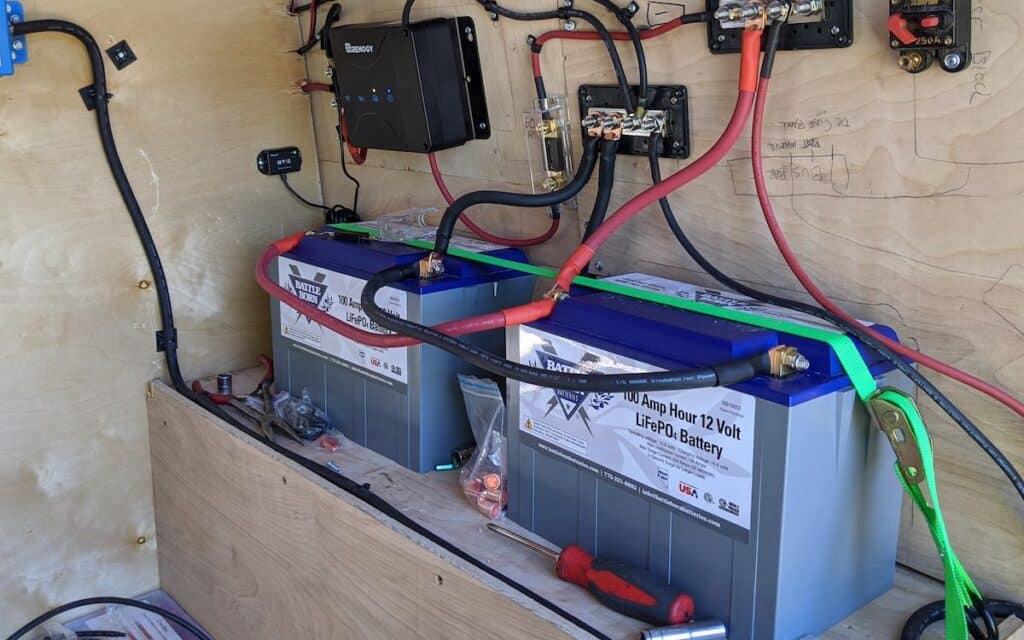
Running a 12V fridge in your van requires a camper van electrical setup that consists of (at a minimum) a 12V outlet connected to an auxiliary battery (not your starting battery), and a means to charge it. But how much power do you need for a van fridge?
Determining Your Battery Capacity
To calculate how much battery capacity you need to reliably run your 12V fridge, first find the average power draw.
As an example, let’s assume our fridge draws an average of 2.0 Amps per hour.
Over the course of one day (24 hours), a 12V fridge drawing 2.0 Amps per hour will drain 48 Ah from your battery.
When sizing your battery bank, you also need to consider the type of battery you have. Lead-acid, AGM, and gel batteries can only be discharged 50% before you start to damage them, so you always want to double your energy usage number to determine your battery capacity. In this example, you would want a minimum battery capacity of 100 Ah – plus additional capacity for your other electrical loads.
LiFePO4 batteries (lithium iron phosphate, or LFP), on the other hand, can be discharged 100%. So in this example, you need at least 48ah of LFP battery just to run your fridge.
However, you would need a bigger battery bank to accommodate your other electrical loads. If you’re cooking in your van, you will need a ventilation fan, which is an additional power draw. Not to mention things like lighting and other kitchen appliances. We always recommend building in some wiggle room if you can.
Important Note: Check out our epic electrical post for a full guide on sizing your van’s electrical system.
Charging Your Batteries
Adding solar power to your van will allow you to stay off-grid while keeping your batteries charged up. We have detailed information on system sizing, installation, and just about everything else you need to know in our epic electrical post.
In addition to solar, it’s a good idea to install a battery isolator or DC-DC charger, which allows you to charge up your batteries from your alternator while driving. This is a great way to keep your batteries topped off when you’re in the woods or in cloudy environments. And if you’re on a budget, you may be able to meet most of your charging needs with just a battery isolator. You can always add solar power as your budget and your needs evolve.
Another option for battery charging is adding shore power to your rig, which allows you to plug in at campgrounds.
Read More
- Epic Guide to Your DIY Camper Van Electrical System
- The Best Solar Panels for Van Conversion Power Systems
- 9 Best RV Solar Panel Kits That Are Actually Legit
- Best DC-DC Chargers and Battery Isolators for Vanlife (How to Charge Your Van While Driving)
Portable Power Stations
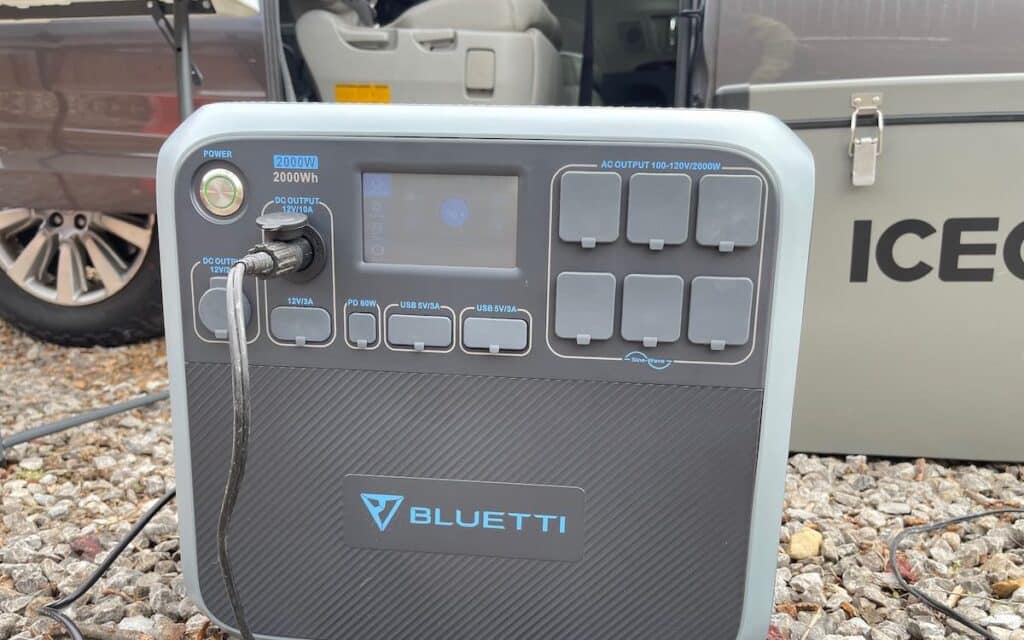
If installing your own electrical system sounds intimidating (it’s not that bad – promise!), then another option is to go with a portable power station like the Bluetti AC200P or Jackery Exporer 1000. The big advantage to power stations is convenience and ease of use, since you have everything wrapped up in one contained power supply.
The Bluetti AC200P has enough LiFePO4 battery capacity, inverter wattage, and DC output ports to fully replace your van’s electrical system. The Jackery Explorer 1000 has enough juice to run a 12V refrigerator and other vanlife necessities for several days, but you will need to be proactive about seeking out sunny weather to keep it charged. There are also other power station options from companies like BougeRV, Ecoflow, Anker, and Pecron.
All of these power stations can be charged via solar power, AC wall outlet, or 12V DC plug while you’re driving.
Read More:
- Bluetti AC200P Review: Portable Power Station for Full Time Van Life
- Jackery Explorer 1000 Review: Is This a Legit Option for Vanlife?
DIY Van Life Refrigerators
If you’re DIY oriented and/or are on a super tight budget, you can build your own inexpensive refrigerator for much less than the 12V refrigerators we talk about in this post. Although these options are cheaper, they do involve extra work, and they may not be as efficient as a purpose-built camper van refrigerator.
Convert a dorm-style fridge to lay on its back
Although you can use a regular dorm fridge or mini fridge in the upright position, you’ll have to find some way to secure the doors, and you’ll have to worry about food shifting and falling out when you open it after driving. But you can solve these problems by turning your mini fridge into a chest style fridge/freezer combo.
To be able to lay your mini fridge on its back, you’ll need to rotate the compressor so that it will be upright in this new configuration. This is the DIY part, but it should be pretty simple. Once you’ve done that, plug your new fridge into a dedicated modified sine wave inverter (wired to your battery bank), and you’re good to go!
Using small top freezer refrigerators like this also allows you to get an instant dual-zone refrigerator for cheap.
Turn a chest freezer into a highly-efficient van fridge
Chest freezers have thicker insulation, so converting a chest freezer into a DIY refrigerator is more power efficient than using a normal fridge. The idea here is to rig up a chest freezer to a thermostat, a small inverter, and a relay that turns the inverter on/off whenever the freezer reaches the temperature you set (so it stays within refrigerator range).
Here are some tutorials we’ve found detailing a DIY fridge-freezer conversion:
- Creating an Effective and Ultra-Efficient Refrigerator (Vandweller’s Reddit)
- Chest Freezer To Fridge Conversion-The Most Energy Efficient Fridge Ever (A Self Sufficient Life)
- Poor Man’s Super Efficient Off Grid Refrigerator (Off Grid Boot Camp)
Now Hit the Road!
A portable 12V refrigerator can really amp up your van life, camping, or RV experience. But these units are not cheap, and it’s important to know that the 12V fridge you’re getting will fit your needs. We hope all the information we’ve presented here has been helpful – but please let us know in the comments if you have a question or you think we left something out.
Even though having a 12V fridge in your van makes vanlife a whole lot easier, don’t let not having a fridge stop you from hitting the road! Plenty of vanlifers make it work with a basic cooler, and you can always upgrade later. Ultimately, vanlife is not about gadgets and HGTV interiors – it’s about enjoying the freedom to create your own life. So get out there and start exploring!

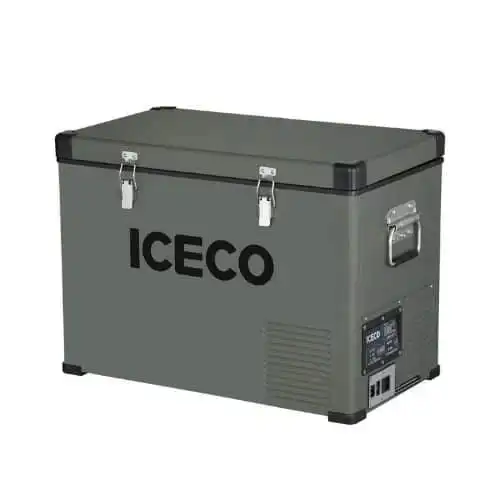
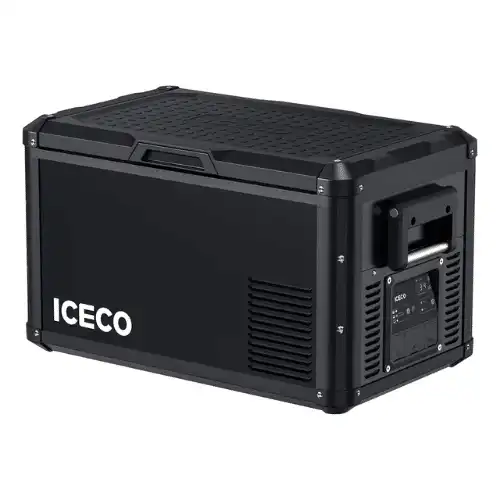

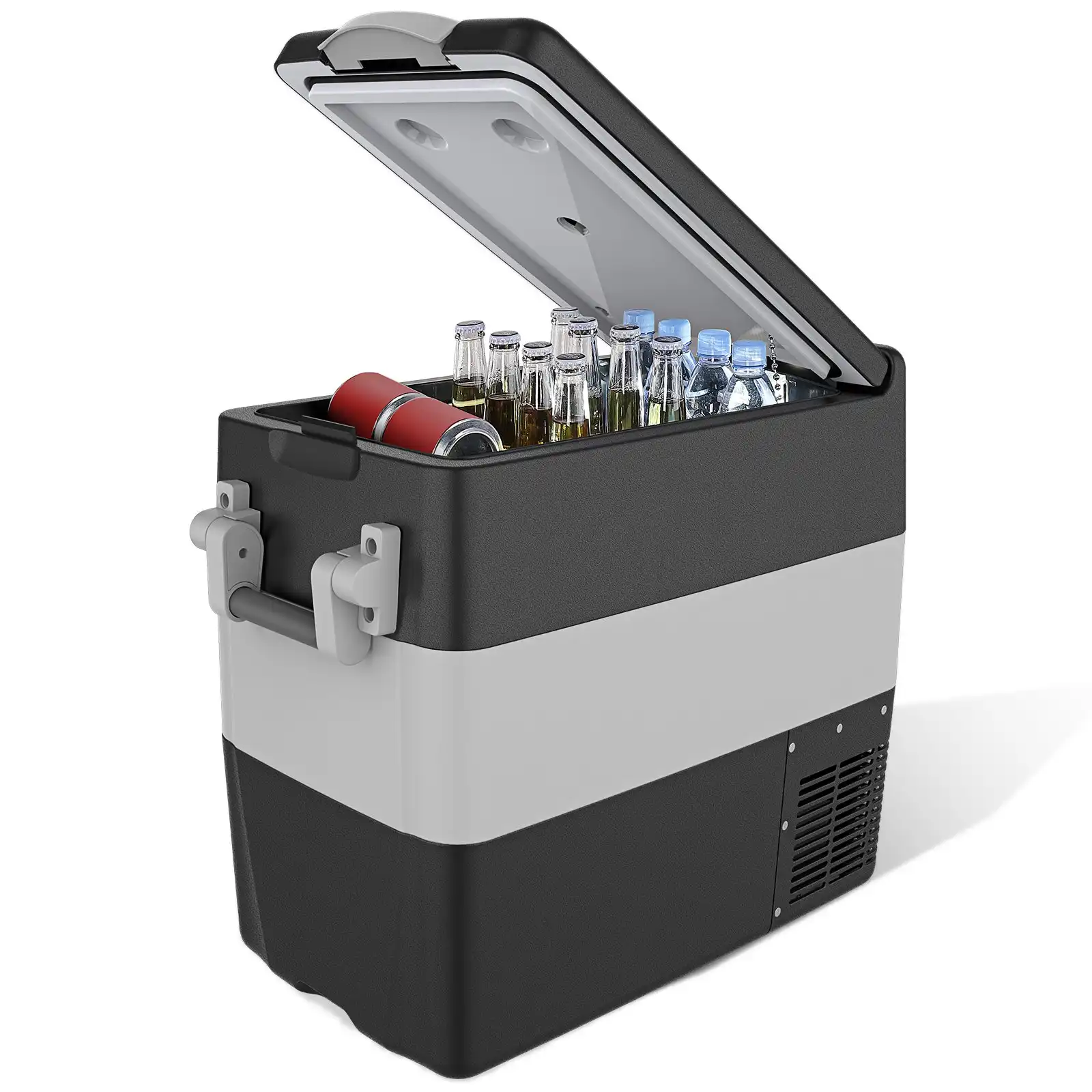
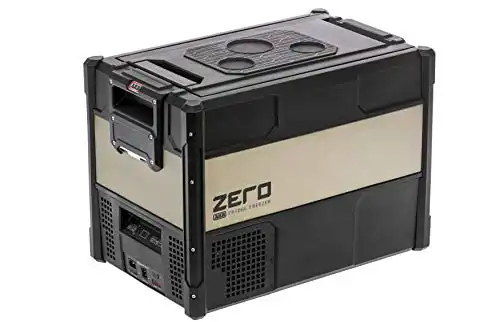
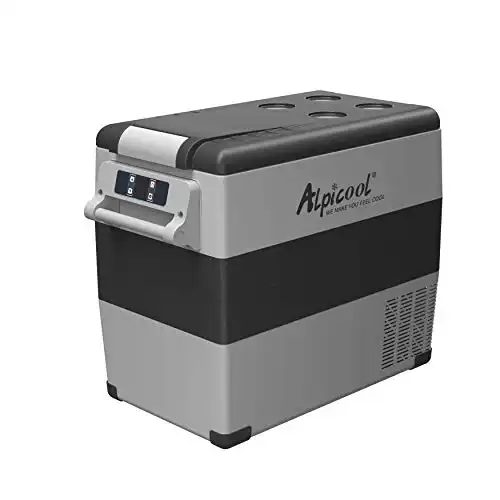
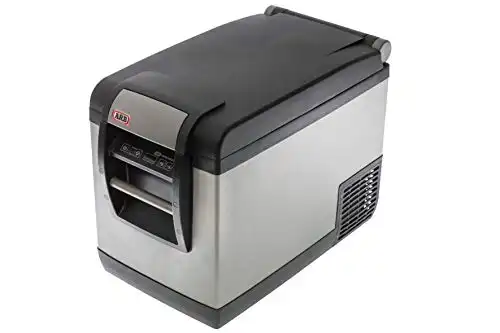
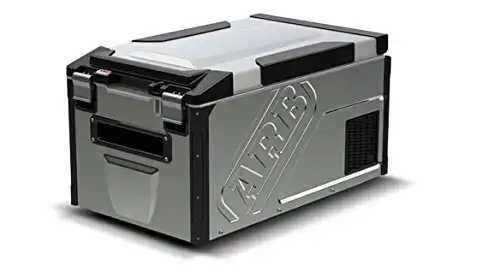
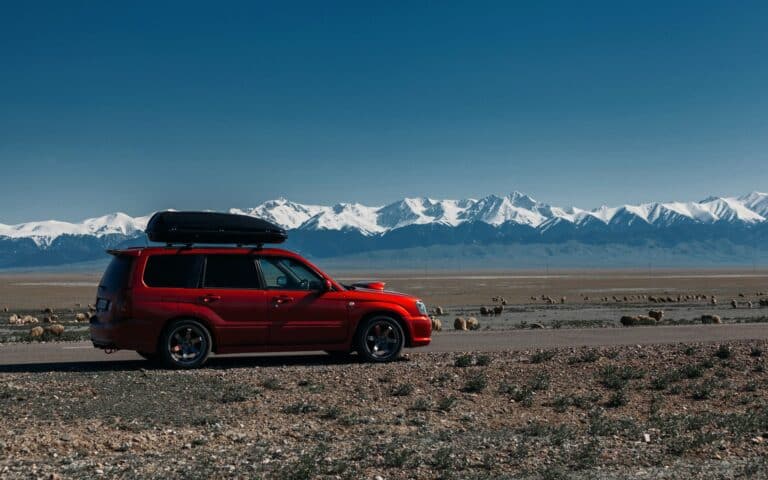
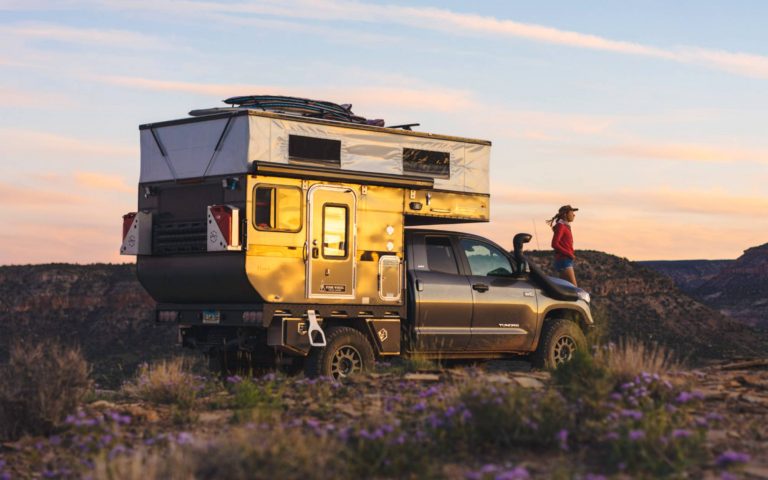
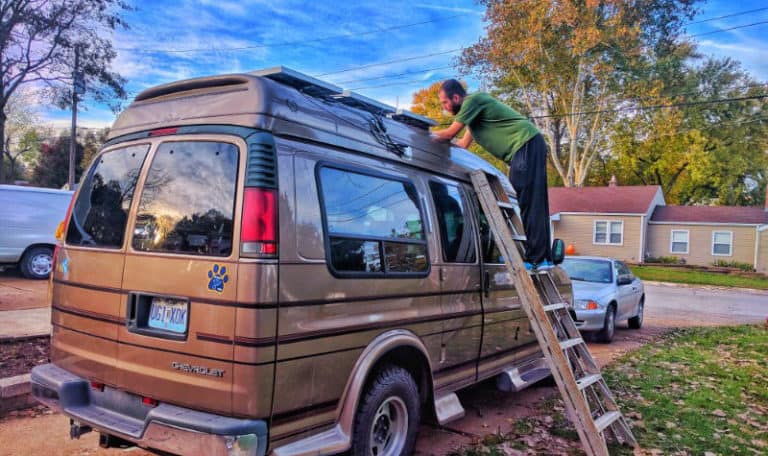
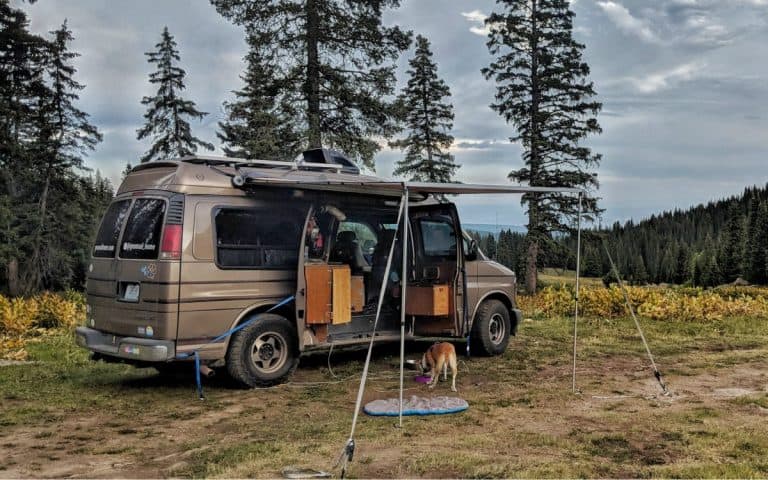
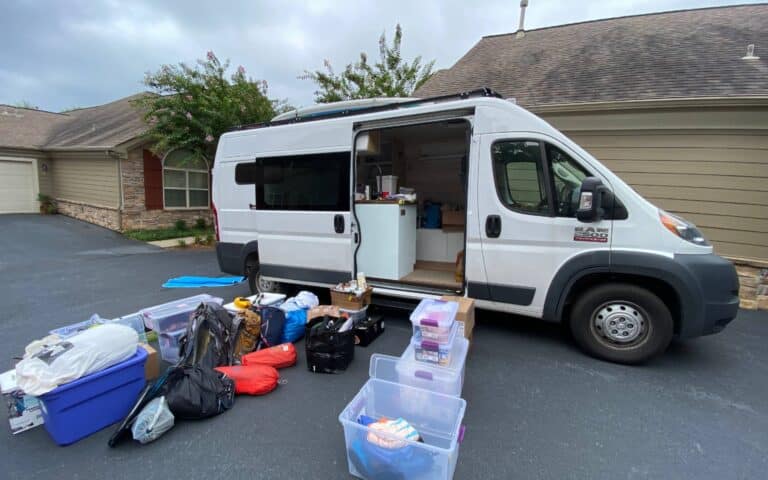
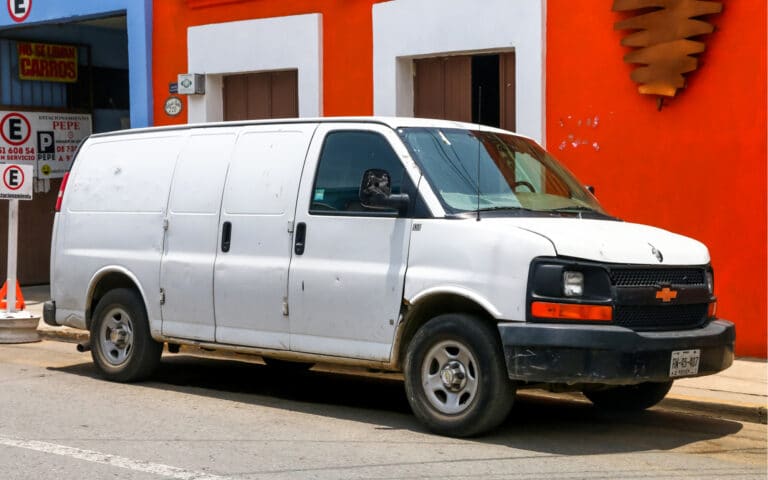
Fantastic post and website! I was feeling a little overwhelmed trying to decide which 12 volt fridge to buy and this review really helped me narrow it down. Thank you so much! I ended up going with the ICECO 78QT VL74 Single Zone and got the Gnomad discount. 🙂 I had an Alpicool 42Q a couple years ago. I really liked it but gave it away to a friend as I knew I wanted to go bigger soon. Hopefully 78Q is big enough as I like to prep meals for the work week. Thanks again!
Hi Jess, so glad you found this article helpful. We’re big fans of our VL45, and the VL78 should be plenty of space!
Thanks for the info! Which fridge is in the photo between the front seat of the minivan. I am looking for something that will fit inbetween the seats of a 2001 Honda Odyssey. Thanks!
Hi Julie, the fridge between the seats is an ARB 50L fridge. However, the van in that photo is a full size Chevy Express, not a minivan. I’m not sure if a fridge that large would fit between minivan front seats, but it might.
This is mind blowing, thanks for sharing.
sad to see the BougeRV codes aren’t working right now, was about to buy one! Please post if you get new codes. Thanks!
Hello, I just tested the codes and they worked for me. Are you outside the United States? Not sure if they work internationally. Let me know if you’re still having issues.
~John
Hi, thank you for sharing all this info! Wondering if I could get your thoughts… I’m building out a Chevy express for 1-2 week trips and weekend camping, and I’d like to avoid the whole electrical, charge control, fuse box, battery set up, and am leaning towards an all in one jackery 1000 with 200w solar panels. For a fridge I think I’ll need a 40-45 liter. As of now the ice co V45 is half the price of the dometics. Is there a significant difference in power draw between the brands, and do you think I have enough power… Read more »
Hi Mark, we actually just published a review of the Jackery 1000 yesterday that you might find helpful in making your decision. You can find it here: https://gnomadhome.com/jackery-explorer-1000-review-vanlife/ I think that the Jackery is a great option for weekend camping and shorter trips. We were actually pretty impressed with it overall. We tested it running an ARB fridge, vent fan, kitchen appliances, lights, and computers. On sunny days it kept pace with our usage pretty well, and we were definitely using quite a bit of power since we were working on our computers for several hours each day. However, as… Read more »
Hi John, this is very helpful thank you! Still sifting through all the solar generator info and reviews and have yet to pull the trigger on one. A couple things about the Jackery are giving me pause… the shorter lifespan of the battery, and only the one DC cigarette outlet. I’m planning to run my lights, fan, and water pump off of one outlet, and my fridge off of another. The new Bluetti 2000w generator seems to have everything I need, and has a lifepo4 battery, but I definitely want to be sure before spending close to $2k. I did… Read more »
Ugh I feel so overwhelmed I don’t even know where to start to choose a fridge
Hi there, it definitely can be a bit overwhelming! Our general advice is to stick to reputable brands – there are a lot of cheap/shitty knock offs out there that draw too much power and won’t last. If you go with models from Dometic, ARB, Engle, Indel B/Truck Fridge (more budget), etc, you’ll be in good hands. There are also more expensive brands like National Luna, but we find that these are a bit overkill for a campervan. Hope that helps!
I notice you don’t list Iceco with the other brands above. Is Iceco a more-recent addition, or does it belong on that list?
Check that. I see it’s the same as Truck Fridge. Thanks. This article helps a lot!
Hi Elwood — Both, actually! Iceco should be listed, and it’s also a more recent addition. We originally wrote this article in 2017 or so before Iceco was a brand and just about every fridge worth buying cost $900, and it’s evolved to include more recent recommendations like Iceco. We’re working on an overhaul of this post to scrap older parts of it and brands that are not as relevant anymore, and put a heavier emphasis on our current recommendations (like Iceco). For the money, I think Iceco is tough to beat, particularly their VL-Series. Their other fridges are good… Read more »
My wife and I are building a van that we can live in full time starting next year. I appreciate your comment about some fridges including digital controls and remote readouts. I imagine that would provide peace of mind. My wife and I are also considering finding a refrigeration repair service provider in case we need it.
I suspect TruckFridge is same as IceCo – specs are identical.
Yup found this:
https://trademark.trademarkia.com/iceco-88206159.html
I have two questions about 12v fridges in general that I have never gotten a good answer to: 1. I’m a veteran cooler user and for years have used frozen water bottles for ice. No wet cooler, can be refrozen easily, and can be used as water after thawing. Do these units have the horsepower in freezer setting to actually refreeze water bottles? If so, I could rotate bottles in and out of a smaller unit to support various coolers. 2. What are real some world experiences with only powering a fridge for a while and then letting it “coast”… Read more »
Hi Jeff, thanks for commenting! To answer your questions: 1. Yes, you can definitely use one of these units to refreeze water bottles. All of the 12V fridges that we mention in this article can go down to at least 0 F (-18 C), and many can dip down to -7 F – plenty cold to freeze water bottles. 2. We don’t have a whole lot of direct experience using a fridge like this, but our ARB fridge is very well insulated. We have had times where we needed to shut off our fridge to conserve battery, and the internal… Read more »
Hi, Looking for a 60q for sprinter stealth RV with solar and trying to choose between ARB and Dometic. Both would suite my needs. Is one of them better at being an occasional seat?
Hi Jon, both are great fridges. As far as which one would work better as a seat, I would take a look at the exterior dimensions of each unit and see if one of them might fit better into your build (one might be taller than the other, etc). Another thing to consider is lid opening direction. ARB fridges hinge from the short side, whereas Dometic fridges hinge from the long side. That can make a huge difference in how you configure your interior. Both are quality units, but sometimes which one you go with comes down to how you… Read more »
lol, I’m pretty sure he was also asking about the sturdiness of the fridge and lid to hold the weight of a person. ; )
Shouldn’t have problems using any 12V fridge as a seat 🙂
No one told me this when I started out but a simple $60 120v fridge from walmart is just as good on power and holds up in a vehicle just fine. (2 years for me now). I got a 1kw inverter from harbor freight bargin bin for $40. So roughly $100 for a fridge that uses about 15a a day in winter and average 45a average with peal of 60a in summer. My charge controller generally registers 500w generated for the day average. (300w system capable of well over 1kw daily). Which means in got batteries to full with only… Read more »
Hi Daryl, thanks for the input and sharing your real world experiences! I’ve also read about converting a chest freezer to a refrigerator and setting up the inverter with a temperature sensor and a relay that kicks the inverter on and off as needed. This seems like an interesting option because freezers have additional insulation built in, and the temperature relay eliminates the problem of power loss by constantly leaving an inverter on. How does your fridge do with off-roading and not being level? For us specifically, we spend a lot of time driving on gnarly forest roads and rarely… Read more »
Level never been a problem. I think thats only a concern for propane to make the flame contact the burner effectively. Im in a 1984 chev hightop G20. I dont do serious overlanding but plenty of potholed gravel roads. I got to stress that i measure amps behind the inverter so whatever its using gets counted. I think inverters are another area where the groupthink comes in terms of expensive pure sine units. I use cheap modified sine wave and only as big as needed. So a 1kw for fridge due to startup draw and a 400w cobra ($40) unit… Read more »
Daryl, do you use the 1kw inverter for the fridge only? (Sounds like you have two inverters — the 1kw dedicated to the fridge, and the 400w for everything else? Just want to make sure I’m understanding your set up — trying to get mine set up at the moment and need all the ideas i can get). Thanks!
Yeah a dedicated 1kw. But ive learned about a hard start capacitor for a fridge. Get one and you can probably either combine a 1kw or go down to a 400w-600w.
https://www.amazon.com/RCO410-Capacitor-Refrigerator-Compressors-PartsBroz/dp/B07MLV25P9/ref=mp_s_a_1_3?keywords=fridge+hard+start+capacitor&qid=1556246697&s=gateway&sr=8-3
Wow! Thanks!
An inverter for $40 won’t be a pure sine wave one, it’ll be a Modified sine wave unit. No way you can get a decent inverter for $40 brand new. I wouldn’t run any fridge or sensitive electronic equipment off a MSW inverter. I bought a 3000W MSW unit for about $40$50 also but my pure sine wave 3kW one was several hundred $.
I bought the Costway 54Q off Amazon, it’s working great so far, and for a fraction of the cost of many of the bigger brands! https://www.amazon.com/Costway-Portable-Refrigerator-Electric-Camping%EF%BC%88-4%C2%B0F/dp/B07CG4Q1YJ/ref=sr_1_4?ie=UTF8&qid=1550274832&sr=8-4&keywords=12v+fridge
Hi Alex, thanks for commenting! We are aware of the Costway fridge and I’m glad it’s been working out for you. I’m in the middle of updating this post with newer info and plan on adding this fridge into the mix. Because of its low cost, the Costway is certainly an attractive option, especially considering that equivalent fridges from more reputable brands cost at least twice as much. But it should be pointed out that Costway is a company that basically imports “white labelled” products from China and rebrands them with their label. There is not much information out there… Read more »
Just a quick note to say that this is the best article and review for On The Road refrigeration that I have seen. Thank you!
Hi Bob, thanks for the kind words! Our goal is to be the most helpful resource out there for nomads, so if you have any suggestions for improvement feel free to let us know!
~John
I am between the Dometic and the ARB, which one do you think runs quieter? I am sensitive to appliance noise and want the quietest one so I can sleep next to it. Thank you!
Hi JD, ARB doesn’t provide noise level specs, but we have the ARB 50 qt and we hardly ever notice when it’s running. We have it up between our front seats, and I only notice noise from the compressor when I’m up front and thinking about it. Dometic does list noise level specs – most of their fridges clock in at 42 dB (this is only when the compressor is running). We don’t have personal experience living with a Dometic fridge for long periods, so we can’t give a subjective comparison. Most all 12V fridges are in the general 35-40… Read more »
Both made by Dometic and both use Danfoss compressor. I think the choice comes down to if you want side opening door or end opening door and Dometic is a little shorter and wider which I prefer.
Hi Bret, thanks for commenting! ARB outsources their manufacturing to Dometic, but their fridge is designed in house and they are not owned by Dometic. Dometic also uses their own proprietary compressor, while ARB uses the Danfoss. But they are both solid units, and I agree that the choice may come down to dimensions and lid orientation.
~John
Ha thanks I didn’t know that. Looks like they changed with CFX series.
“The most significant difference between our CFX and CF models is our CFX has a WAECO compressor, and the CF line uses a SECOP compressor. The VMOS (Variable Motor Speed Optimization) controller was to VMOS2 in our CFX line, which together makes our CFX more efficient than our CF models.”
I’ve heard people shutting off their Dometic cooler at night while sleeping and there only being a small temp difference in the morning. This may be the only choice for those that are bothered by the noise. I wish this article did list all the decibel levels. If you read Dometic reviews on Amazon you hear people saying “it is louder than I thought it would be,” so John seems correct since most use the same compressor that 35-40dB is about right, and there’s no good solution beyond going with an ice using one. There are videos of people putting… Read more »
Hi Walt, thanks for commenting! We do list decibel levels in our mega spreadsheet, which you can get access to by entering your email in the form within this article. However, many fridge manufacturers do not make these levels available. In our personal experience, we’ve found that placement of the fridge also affects things. We had our fridge up front between the driver/passenger seats, which ended up blocking a lot of the noise to the point where we did not even notice it. However, we’re currently stationary and have our fridge plugged into a wall outlet, and we can definitely… Read more »
Anyone have specs on the TruckFridge65 as far as incline? I have an app on my phone to measure it so was going to see when I should shut it off. I’ve looked all over Al Gore’s internet and nothing. Portables claim 30deg. What about fixed? Specifically TF65? Thanks! My VW Eurovans fridge got put out to pasture. Can’t be happier with the new TruckFridge TF65.
Hi Paul, I couldn’t find anything either! I know that all TruckFridge units use Danfoss/SECOP compressors, which are also used in the portables. Plus these fridges are built for RVs and trucking, so I would imagine that they can operate at a similar incline as the portable units (30 degrees). If you want to know for sure, I had good luck contacting TruckFridge with questions. Here’s their contact page: https://www.truckfridge.com/contact-us/
Hope that helps!
~John
I dont know where you guys got the warranty information.. On Amazons website for the CFX50 that you recommend, it says the warranty is 1 year on the compressor and 2 years on parts. Its a poor warranty from what I am reading and a lot of money for their product!
Hi Jeana, we found that warranty information from several sources, but I just followed up with Dometic directly and the 3+2 warranty is only offered in Australia. Thanks for catching this! In the US, Dometic currently offers a 2-year warranty, but according to them that covers all parts, labor, and defects, and is automatically in place (i.e. no registration required). They also offer an extended warranty for up to an additional three years. If you’re looking for a longer base warranty, ARB and Engel both offer 3-year warranties on their fridges. Dometic fridges are certainly not cheap (nor are the… Read more »
ARB fridges are made for ARB by Dometic
Hi Charly, that is correct. Dometic is a huge fridge manufacturer, and they actually manufacture units for several other brands. ARB fridges are engineered entirely in house at ARB, so Dometic has nothing to do with the design of the product, but they do manufacture them for ARB.
~John